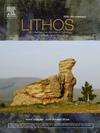Formation of giant gold deposits driven by delamination of carbonated cratonic lithosphere
IF 2.9
2区 地球科学
Q2 GEOCHEMISTRY & GEOPHYSICS
引用次数: 0
Abstract
Delamination of the thick continental lithosphere of the craton is an important geological process that accounts for the recycling of continental materials. However, links between such a process and the formation of giant ore deposits are controversial. Although a recent study suggests the base of the cratonic lithospheric mantle at depths of 160–190 km is particularly enriched in sulfur and could be a significant gold reservoir, the mechanisms responsible for gold release are poorly understood. The Jiaodong gold deposits in the eastern North China Craton (NCC) are defined as a giant gold province with approximately 5000 tons of Au. Using new advanced Au analytical technologies, we measured the Au concentrations of 86 samples to determine the Au background values of possible source candidates. The crustal candidates, including Precambrian metamorphic crustal basement (average Au: 0.20 ng/g) and Mesozoic granites (average Au: 0.05 ng/g) from the Jiaodong area, as well as supracrustal rocks from the northern South China Block (SCB) (average Au: 0.12 ng/g), exhibit no discernible Au anomalies. Nevertheless, local mafic dikes, spatiotemporally associated with Au mineralization, exhibit slightly higher Au contents (up to 3.13 ng/g) than other candidates. In-situ laser ablation analyses of S-rich minerals in the mafic dikes reveal heavy sulfur isotopic compositions (δ34S ranging from −3.4 to 17.4 ‰), systematically higher than the mantle value (δ34S = −1.4 ± 0.5 ‰). Since the effects of crustal contamination and sulfide segregation are negligible, the heavy S isotopic compositions of Jiaodong mafic dikes may indicate a potential contribution of heavy sulfur isotopes from marine carbonates or sulfide oxidation in the mantle. The high Fe3+/∑Fe values (up to 0.43) of the mafic dikes also indicate derivation from a highly oxidized mantle source. Given that their low δ26Mg values (−0.59 ‰ to −0.24 ‰) have indicated a mantle source partially metasomatized by recycled carbonates, we hypothesize that the reduction of carbonates in deep (>250 km) delaminated cratonic lithosphere may have facilitated the oxidation of sulfides to sulfate, potentially providing a mechanism for the liberation of gold from the mantle.
碳酸化克拉通岩石圈剥离作用下巨型金矿床的形成
克拉通厚大陆岩石圈的剥离作用是解释大陆物质循环的重要地质过程。然而,这一过程与巨型矿床形成之间的联系是有争议的。尽管最近的一项研究表明,在160-190公里深处的克拉通岩石圈地幔底部特别富含硫,可能是一个重要的黄金储层,但人们对黄金释放的机制知之甚少。胶东金矿床位于华北克拉通东部,是一个金储量约5000吨的巨型金矿大省。采用新的先进的Au分析技术,我们测量了86个样品的Au浓度,以确定可能的候选来源的Au背景值。胶东地区前寒武纪变质地壳基底(平均Au: 0.20 ng/g)、中生代花岗岩(平均Au: 0.05 ng/g)以及华南地块北部的表壳岩(平均Au: 0.12 ng/g)均未发现明显的Au异常。然而,与金矿化有关的局部基性岩脉,其金含量略高于其他候选岩脉,最高可达3.13 ng/g。对基性岩脉富s矿物进行原位激光烧蚀分析,发现其硫同位素组成较重(δ34S =−3.4 ~ 17.4‰),明显高于地幔值(δ34S =−1.4±0.5‰)。由于地壳污染和硫化物分离的影响可以忽略不计,胶东基性岩脉的重硫同位素组成可能表明来自海相碳酸盐或地幔硫化物氧化的重硫同位素的潜在贡献。基性岩脉的高Fe3+/∑Fe值(高达0.43)也表明其源自高度氧化的地幔源。其δ26Mg值(- 0.59‰~ - 0.24‰)较低,表明地幔源部分被再循环碳酸盐交代,我们推测深层(>250 km)克拉通脱层岩石圈中碳酸盐的减少可能促进了硫化物氧化为硫酸盐,可能为地幔中金的释放提供了机制。
本文章由计算机程序翻译,如有差异,请以英文原文为准。
求助全文
约1分钟内获得全文
求助全文
来源期刊

Lithos
地学-地球化学与地球物理
CiteScore
6.80
自引率
11.40%
发文量
286
审稿时长
3.5 months
期刊介绍:
Lithos publishes original research papers on the petrology, geochemistry and petrogenesis of igneous and metamorphic rocks. Papers on mineralogy/mineral physics related to petrology and petrogenetic problems are also welcomed.
 求助内容:
求助内容: 应助结果提醒方式:
应助结果提醒方式:


